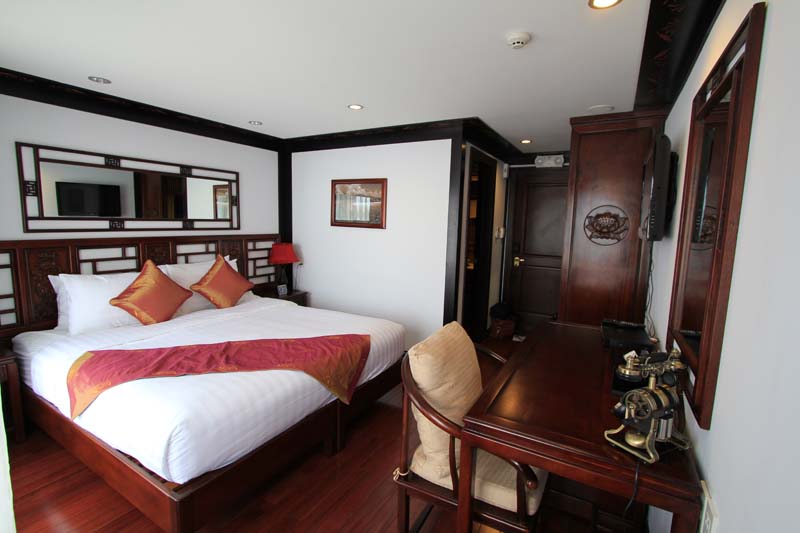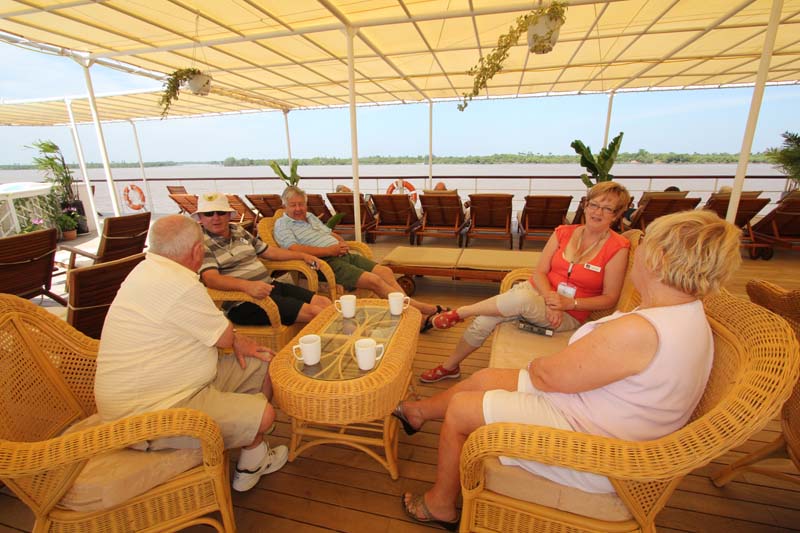
My introduction to daily life on the Mekong River began with a boat journey from Tonle Sap Lake, near Siem Reap in Cambodia, to the floating hotel I would call home for the next seven night on my Mekong River Cruise, the RV AmaLotus. En route, we passed entire villages built on the water. Homes, schools, markets and even basketball courts floated alongside the riverbanks, mostly inhabited by the families of fishermen who use this liquid highway to earn their living.

After a few days in Siem Reap, where I discovered the incredible Angkor Wat complex and more, I was continuing my 13-day exploration of Cambodia and Vietnam following the mighty Mekong River with APT. As I pondered the adventures still ahead of me, the sounds and sights of children playing, women gossiping while chopping up fish, men arguing over a broken boat engine, and cats and dogs jumping from one barge to the next filled my ears and eyes. It was lively and energetic, and no-one batted an eyelid at the boatload of tourists passing by.

After half an hour or so, we arrived at the ship, marking the official beginning of our journey down the Lower Mekong River from Cambodia to Ho Chi Minh City in Vietnam. The Mekong River cruise would introduce us to local communities like the ones we’d just seen, rural villages whose inhabitants’ lives revolved around the river. We would also visit better known sights such as Cambodia’s capital Phnom Penh along the way. It’s an adventure designed to uncover the secrets of the Mekong and immerse us in its local way of life, accessing locations otherwise untouched by tourism.

We were welcomed on board the river ship with refreshing hand towels and smiles that lit up the faces of our Cambodian and Vietnamese crew. The RV AmaLotus is a modern and stylish boutique ship that carries just 124 passengers. Guest suites are spread over four decks; most have private balconies from which you can watch the scenery glide peacefully by. There were also lounges with terrific views, plus a swimming pool, spacious restaurant, library, fitness centre and day spa that proved popular for foot massages.

On our first night, drinks in one of the teak-hued lounges with the captain were followed by an Asian-and Western-inspired dinner in the restaurant and live piano music. The atmosphere is relaxed and intimate, and new friendships are quickly formed, ones that would grow over card games, G&Ts on the sundeck and new adventures on land.

I relished the thought of unpacking just once, yet able to visit a new destination each day. Relieved of having to check in and out of hotels, I needed only to concentrate on the adventures ahead and enjoying the ship’s considerable comforts.

One of our first shore excursions saw us disembarking in Prek K’dam, and climbing aboard traditional ox carts to experience the ‘local transport’. Many of the rural villages we visited on this trip have been welcoming foreign tourists for only a short time, and in many ways locals here are still living as they have done for hundreds of years. In the interests of boosting the local economy through tourism, rice farmers down tools for an hour and come from all around to offer their ox carts for our enjoyment. Our guide Pisak told us that life has been tough for the locals, but the arrival of more tourists has opened up another income stream for them.

Bumping our way into the village of Kampong Tralach, we passed rice fields and happy, excited children who run beside us. As we travelled along the little town’s main street it felt as though we had taken over the village, but we couldn’t be made to feel more welcome – everyone waved at us with a smile and it felt like a celebration.

We then were taken to the nearby town of Oudong, once a royal capital and now home to one of the largest Buddhist monasteries in Cambodia; anyone can join a meditation retreat here. We entered one of the largest pagodas to witness a magical monk-blessing ceremony, and left with the musical chanting still in our ears.

As the ship continued towards Phnom Penh, our trip was broken up by stops at several other villages along the way. Each had its own speciality, such as the village of Chong Koh, known for silk weaving. Every stop gives us further insight into life on the river, allowing us to see how livelihoods are sustained.
Throughout the journey, my fellow passengers and I couldn’t help but be affected by Cambodia’s most recent tragic history. Most of the people we spoke to, such as local tour guides or the farmers who transported us on their ox carts, had their own heartbreaking stories to tell from the brutal Pol Pot era. It quickly became clear though that Cambodians are a resilient people, optimistic about their future and the opportunities that lie ahead.

It is in Phnom Penh that we were confronted with the darkest realities of this era, when we visited the Tuol Sleng Genocide Museum. Known as S-21 (short for Security Prison 21), this was a former high school that was turned into a prison during the Khmer Rouge regime from 1975 to 1979. One of around 150 detention and torture venues in the country, it housed more than 17,000 people who were later sent to the nearby notorious Killing Fields of Choeung Ek for execution.

This sombre excursion affected all of us deeply, especially after we visited the Killing Fields themselves. It was an incredibly emotional day and we sought comfort from newfound friends over dinner that night, sharing what the day evoked for each of us. On that poignant note, we farewelled Cambodia with a traditional Khmer dance on board the ship and looked forward to sailing into Vietnam the next morning.

Our group was inducted into the Vietnamese way of life via cycle rickshaws in the small town of Tan Chau. Winding our way around the haphazard streets, ducking and weaving between bicycles, motorbikes and dogs, locals waved and pointed amusedly at us as they went about their daily business. I couldn’t help myself and asked my driver if we could swap places. He agreed and giggled behind me, obviously unused to being the passenger, and I discovered muscles in my legs that I never knew existed.

We headed back down to the river via a floating fish farm, where small boats took us to the Evergreen Islands, a group of islands in the Mekong Delta that are practically untouched by tourism. The islands’ inhabitants live in stilt houses poised over rice-paddy fields, and we were greeted by groups of friendly children who spontaneously invited us to visit their homes. We gratefully accepted and climbed a ladder into one house, touched by the generosity and hospitality of these strangers.

Our journey towards Ho Chi Minh City continued via the slightly larger town of Sa Dec. A local market here had some interesting produce on sale – freshly prepared mice, rats, eels and snakes were the speciality, sold next to standard Vietnamese fare such as pineapples, green vegetables, rambutans and rice. The markets were a place of colour, vibrancy and noise and are clearly the hub of the community. Women crouched on the ground, gossiping amongst themselves and selling their goods in-between chats.

Our farewell dinner on the ship’s last evening was an emotional one. Ho Chi Minh City awaited but I was in no hurry to leave my floating hotel. The camaraderie and friendships that had been forged over the last eight inspiring, and at times emotional, days were hard to say goodbye to. I would miss the crew, from the bartender on the sundeck who knew my drink by heart, to the team who made up my room each day and the chef who prepared my pho (rice-noodle soup) at breakfast. It’s amazing how attached we had all become to them and their incredible hospitality in just one week.

This was a clever and memorable journey, an experience that shows how age-old traditions still have a relevant place in society and that in places like these, community is still king. In many ways it was the local people who made the trip, from the villagers along the river to the crew on board, each sharing their own backyard, story and smile.
LEAVE A REPLY